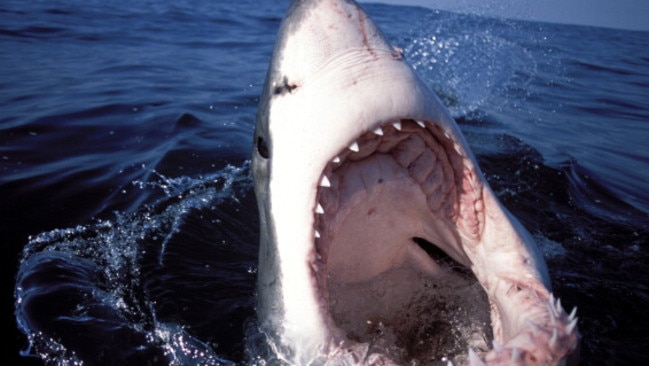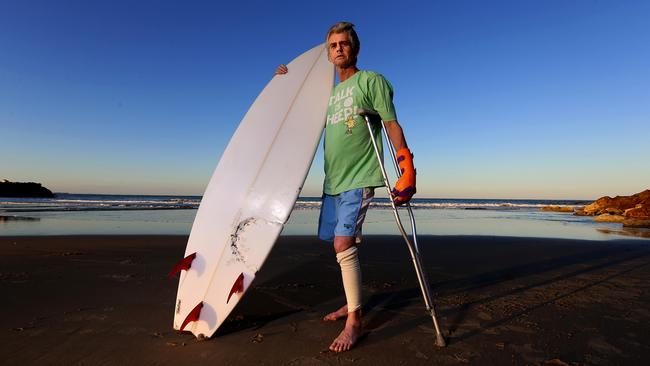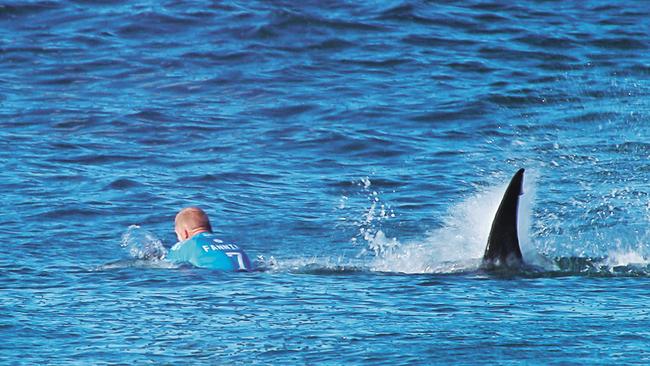Shark victim Craig Ison says a solution to attacks is needed, but culls not the answer
SHARK attacks in Australia have never been higher causing victims and experts to call for a rethink on our relationship with them.

“THERE’S nothing quite like the feeling of being torn apart by a wild beast,” Craig Ison tells news.com.au about his near lethal encounter with a shark last month.
Near perfect conditions greeted the keen surfer from Evans Head, on NSW’s north coast, as he ventured into the water early on a bright August morning.
The peace didn’t last long. A great white shark shot clear of the waves and headed straight for him. Its teeth tore through Mr Ison’s left arm before grabbing hold of his leg and taking a chunk out of his board.
“I thought I was stuffed to put it mildly,” he said.
It took three hard jabs to the head to loosen the animal’s grip.
“I wasn’t pussyfooting around, the first two punches missed the target but with the third one he fell off me and just went limp,” he said.
Mr Ison, who only recently left hospital, features in tonight’s episode of Insight, on SBS1, which asks why there has been an increase in shark encounters and whether it’s safe to go back in the water.

The program coincides with a high-level shark summit, held today at Sydney’s Taronga Zoo, which was charged with assessing new technologies to help reduce the number of shark attacks. But, more radical solutions have been raised including killing individual sharks or even mass culling.
TOP STATE FOR SHARK ATTACKS
According to Taronga Zoo, this year there were 29 encounters between humans and sharks with 18 injuries and two deaths. The numbers exceeded last year where 23 attacks led to 14 injuries and five fatalities.
NSW has been a particular hot spot with more attacks and injuries than all other states combined.
“The great white has been protected for 18 years, so if you start looking at the numbers they’re going to start populating,” said Mr Ison.
“It’s going to worse before it gets better.”
Last year in Western Australia, a government sanctioned cull saw more than 150 sharks caught on baited drum lines of which 50 were subsequently destroyed. None were great whites.
While the NSW Government has said a cull is not on the cards, support is growing. Lennox Head surfing legend Chris “Brocky” Brock, said the logical solution was to reduce the number of great whites before another person lost their life.
“I think culling them is the wisest thing to do,” he told the Daily Telegraph.
“I’ve been surfing here since the early ‘60s, and there were sharks, but you very rarely had someone get attacked by a shark like you’ve got now; there’s too many.”
SHARK KILLINGS MORE PR THAN PREVENTION
Dr Christopher Neff, a shark expert at the University of Sydney told news.com.au a cull was not the solution while the targeted killing of sharks implicated in attacks was even more pointless.
“It’s a public confidence boosting measure, there’s no scientific proof killing individual sharks reduces the risk of shark bites.”
In exclusive research given to news.com.au, Dr Neff said even local communities affected by shark attacks were sceptical of moves to introduce individual kills. In Ballina, where Tadashi Nakahara was killed in an attack in February, less than a quarter of those surveyed thought shark kills were primarily about protecting the public. In contrast, 45 per cent thought their main purpose was to calm the public and 27 per cent said it was more about reassuring rattled tourists.
“The data suggests the public see this as a providing an emotional relief not providing safety,” he said.

The Sydney summit has looked into a number of new shark deterrent technologies ranging from electric barriers and improved shark nets, which are less harmful to other marine life, to lifebuoys or tags which could alert lifeguards if sharks were close.
NO 100 PER CENT SOLUTION
But there were no magic bullets to solving attacks, Dr Neff said. Provding surfers and swimmers with more information on shark movements would help but it’s unlikely we could ever tag all sharks and current nets are only partially effective and are not a solution for many ocean beaches.
“It’s important to recognise there is no easy solution to this. You can’t shark-proof Australia but I do think some of the technology can help reduce risk in specific situations.”
The increase in attacks could be as much to do with our rising population and increased numbers of people in the water as a rise in the number of sharks, he said.
“We need to treat the beach like the bush where we’d be aware we might see a brown bush snake.
“People should be able to swim but people should do so with the reality that, in very rare events, sharks and swimmers do come into contact,” said Dr Neff.
Mr Ison is excited by electromagnetic bands which surfers could wear to help repel sharks. However, he admits even this would not have stopped the attack that left him hospitalised.
“There is a 100 per cent safe way of not getting attacked and that’s by not getting in the sea,” he said, “but it isn’t practical and it’s no good for the tourism industry”.
“It’s their territory and you’ve got to have a happy medium, that’s why I’m looking for a solution that doesn’t cause death to the shark but saves us from being chewed to pieces.”




